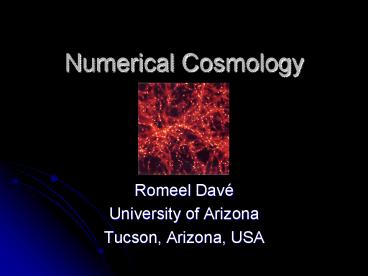Numerical Cosmology - PowerPoint PPT Presentation
1 / 15
Title:
Numerical Cosmology
Description:
Space itself expanded, and continues to expand except where bound locally by ... be precisely determined from CBR anisotropy measurements and redshift surveys. ... – PowerPoint PPT presentation
Number of Views:37
Avg rating:3.0/5.0
Title: Numerical Cosmology
1
Numerical Cosmology
- Romeel Davé
- University of Arizona
- Tucson, Arizona, USA
2
Our Universe As We Know It
- We live in an dark matter dominated,
inflationary, Big Bang universe. - Universe began 13.8 billion years ago, in an
explosion of super-hot super-dense plasma. - Space itself expanded, and continues to expand
except where bound locally by gravity (e.g on
Earth, or in our Galaxy). - The expansion is governed by Hubbles Law
vrecessionH(t)?d, where H is Hubbles
constant. - Echoes of the Big Bang are visible today as
Cosmic Background Radiation
3
Inflation(if you thought the Big Bang was wacky,
wait till you hear this!)
- Less than 1 second after the Big Bang, the
Universe underwent a sudden burst of expansion,
growing by gt1060 in a fraction of a second. It
then resumed normal expansion. - Quantum vacuum fluctuations (much like white
noise on a TV) were frozen in at this epoch. - It is these fluctuations that eventually give
rise to galaxies, stars, and us! - While there is no direct observation of
inflation, it is required to explain causality
within our observable Universe, among other
things.
4
Cosmic Background Radiation
- Comes to us from recombination epoch, when
Universe became cool enough for protons and
electrons to form H atoms. - WMAP power spectrum shows wiggles characteristic
of Big Bang.
5
Dark Matter
- We are made of ordinary matter, or what
Astronomers call baryonic matter. Baryonic
matter interacts with electromagnetic radiation
(light), via reflection, refraction, or
absorption. - But we are in the minority 90 of the Universes
mass is non-baryonic dark matter! - We cannot see dark matter directly we infer
its presence from its gravitational effects on
the baryonic matter we can see.
6
Galaxy Rotation Curves A Dark Matter Indicator
7
The Accelerating Universe
- Recently, astronomers have observed that our
Universe is not just expanding, but accelerating! - The Universe contains a vacuum energy, causing
pressure that drives the acceleration (think of
it as slow inflation). - Einstein actually introduced such a term in his
equations of General relativity to prevent the
Universe from accelerating he called it his
greatest blunder, since had he not done so, he
would have predicted an expanding Universe! - Ironically, this same term (with the opposite
sign) is now invoked to produce an acceleration.
8
The Fate of Our Universe?
9
The Constituents of Our Universe
- Densities are measured in terms of the critical
density, i.e. the amount of mass-energy it would
take to just halt the expansion due to
self-gravity. - Matter density Wm0.27
- Baryonic matter density Wb0.04
- Vacuum energy density WL0.73
- Hubble constant (today) H072 km/s/Mpc
10
Structure Formationand the Cosmic Web
- Initially, density fluctuations are small. They
grow via gravitational instability. - Matter collapses into pancakes, then onto
filaments, creating a Cosmic Web. - Eventually it breaks away from Hubble expansion
and collapses on itself, forming a galaxy. - Galaxies cluster hierarchically into groups,
clusters, and even super-clusters.
11
Galaxy FormationWhat about the Baryons?
- Gravitational instability of dark matter is
halted by angular momentum. - But dark matter cant form the things we see.
Why? It cant dissipate! - In the centers of galaxies, baryons dissipate
their gravitational potential by radiative
cooling, and can condense to form stars. - A galaxy is born!
12
Galaxy Redshift Surveys
- The hardest problem in astronomy What is the
distance to an observed object? - Can obtain a good estimate using Hubbles Law
(vrH0d) If we measure recession velocity, we
know distance! - Recession results in characteristic emission
being redshifted (i.e. Doppler shifted to longer
wavelengths) by measuring the redshift, one gets
velocity and hence distance. - Redshift surveys are thus used to map the galaxy
distribution.
13
The Cosmos on a Computer
- Structure formation is highly nonlinear. Our
solar systems overdensity is 108! - Easiest way to model is to numerically follow
growth of perturbations into nonlinearity. - Model random subvolume of Universe using many
particles, each representing a bit of mass
(typically a million to a billion Suns!). - Simulate Compute forces on particles from
gravity, pressure advance particles positions
repeat until end!
14
(No Transcript)
15
Summary
- We live in a dark matter-dominated, inflationary
Big Bang Universe. Moreover, the expansion
appears to be accelerating. - The parameters of our Universe can now be
precisely determined from CBR anisotropy
measurements and redshift surveys. - The growth of structure can be modeled using
computers, allowing theories to be tested and new
phenomena to be elucidated.































